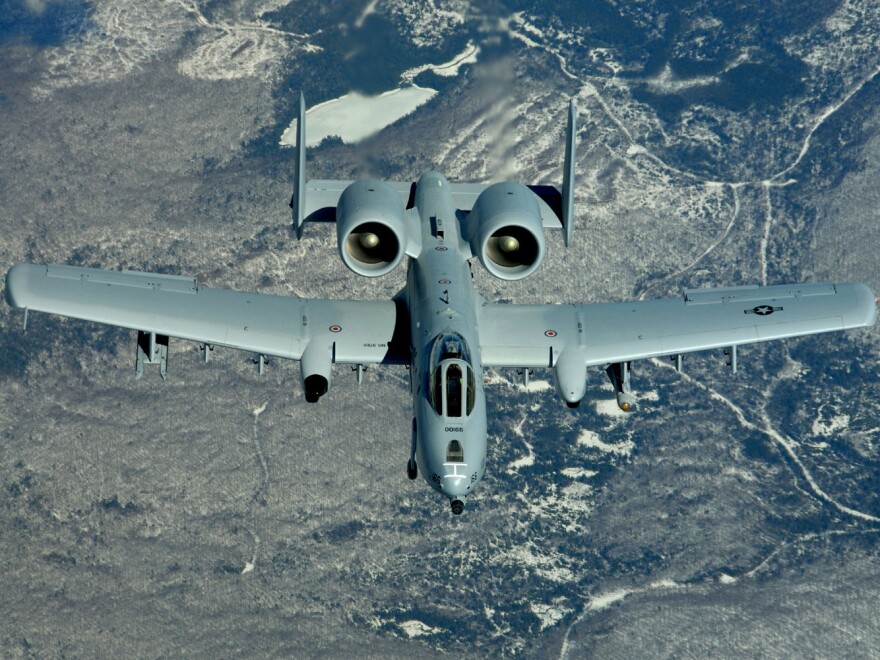Jeff Duford is standing next to an A-10, one of the most beloved planes of all time. It's painted green, a clue that it was designed for a threat that has disappeared — it was built at the height of the Cold War.
"The reason why it's painted this way is because at that time, this airframe was expected to stop Soviet tanks from rolling through Germany," says Duford, curator of the National Museum of the U.S. Air Force in Dayton, Ohio. "So it's painted to kind of match the terrain that one would find in Central Europe."
But the Air Force is facing some lean years ahead, and efforts to balance the budget now threaten to ground the 343 A-10s — and that has led to a backlash. Defenders of the plane say it can't be retired until the military has a replacement that is just as good at protecting ground troops.
The A-10 saga is a good example of a problem the military faces when it tries to kill any plane, or almost any weapon. With time, the weapon gains a world of supporters, making it very hard to cut the billions the Pentagon needs to save.
The A-10 has a lot of support because it turned out to be well-adapted to new scenarios after the threat of Soviet tanks faded. For example, the A-10 can operate in austere environments — like the deserts of Iraq and Afghanistan — because of its unique engine design, Duford says.
The A-10's engines are mounted not in the wings, but high off the ground by the tail section. "They're much less likely to suck in debris that might be on a rough runway," Duford says. "That kind of thing going to a jet engine can destroy the engine."
The plane has a bucketful of other tools that make it a scary weapon, useful for the low-tech fighting in Afghanistan. It's heavily armored, enabling the pilot to get in close without fear of being shot down. Big fat wings let the plane fly low and slow. It also has an amazing nosegun, the GAU-8.
"The A-10 is built around this gun," Duford says. "The gun itself and the ammunition system dominate the whole front half of the aircraft."
This gun is part of the reason experienced infantrymen grow misty-eyed when they recall how this machine saved their bacon. YouTube is full of unauthorized battlefield videos showing the plane unloading nearly 4,000 rounds per minute of armor-piercing bullets that can destroy a tank or level a building.
But despite the support from airmen and infantrymen, Gen. Mark Welsh, the Air Force chief of staff, says he has to answer this budget question:
"How do you save dollars that have a 'B' after them, instead of amounts of dollars that have an 'M' after them?"
Welsh needs to save tens of billions of dollars because the Air Force budget is plummeting to earth. He says if he just idles a few planes, he'll still have come up with spare parts for those that remain. But if he mothballs all 343 A-10's, he'll save serious money.
It's not a decision he enjoys making, as Welsh, a former pilot, told Congress earlier this year.
"A-10 was my first fighter," Welsh said. "I love the airplane. I have a thousand hours flying it. It is the best airplane in the world at what it does — it is not the best at a lot of other things."
The A-10 is a single-mission aircraft at a time when multi-mission planes are needed, according to Welsh and others.
But don't say that to A-10 veterans like Pierre Sprey, who helped design the A-10 and other planes, unless you're ready for a fight. He attended a recent conference with other A-10 fans in Washington, D.C.
"I'm here, and I guess a lot of people in this audience are here, because we're outraged by the Air Force's latest attempt to kill the A-10," Sprey said.
To him and many others, the Air Force is giving up on the plane before it has a replacement ready to help protect ground troops. Sprey says this debate is not about trying to keep a popular airframe flying forever.
"What it's really about," he says, "is the future of close air support and, in an even larger sense, the future of real and effective air power."
If the A-10 is retired, it will be a victim of tight budgets, but also of history. The U.S. fleet used to have lots of planes designed for specific tasks, but Jeff Duford of the Air Force Museum says that planes today have to be more flexible.
"More capabilities are being put on single airframes," Duford says. "That does kind of leave open a question about single-use aircraft: what is their place?"
Copyright 2021 NPR. To see more, visit https://www.npr.org.






